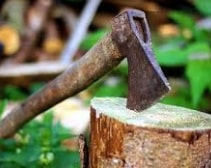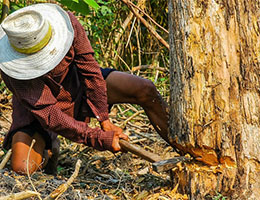 The Frankish word hapja came into French as hache , which in Spanish became axe . This is the name given to a tool that consists of a handle and a cutting steel blade .
The Frankish word hapja came into French as hache , which in Spanish became axe . This is the name given to a tool that consists of a handle and a cutting steel blade .
Axes are generally used to fell trees and cut wood . However, throughout history they were also used as weapons , even thrown. That is why there are different types of axes.
At a general level it can be said that an ax consists of a wooden handle - which the user must hold with one or both hands - and a metal blade attached to said handle. The person must make the blade impact forcefully on the surface they intend to cut.
The origins of the ax date back to prehistoric times, when man attached polished or carved stones to a stick to create a weapon that allowed him to defend himself or attack other humans or wild animals. Over the years, they began to make metal-based blades.
Axes manufactured at a military level are called war axes . Unlike common axes used for felling and chopping, these tomahawks have a longer handle and a sharper blade. The Viking or Danish ax and the Franciscan ax are two types of war axes.
A tomahawk is an ax used by Native Americans and European settlers several centuries ago. In addition to being used in hand-to-hand combat, the tomahawk ax was used as a throwing weapon.
The idea of an axe, on the other hand, can refer to a large wax candle shaped like a quadrangular prism or to a tar and esparto wick that does not go out despite the wind.
Nowadays, many people use the ax in their routine, both at home and at work, as it has become a very useful tool. It is important to note that the ax is not only used to cut trunks but can also be used to prune plants whose branches are too thick for conventional scissors. Despite the practicality that the ax may offer and the fact that it is not a particularly expensive product at a monetary level, we must know the recommendations for use and the risks of incorrect handling, both for our safety and that of those around us. .
 Let's see below some of the fundamental points that we must take into account when using an axe:
Let's see below some of the fundamental points that we must take into account when using an axe:
* the recommended angle for using an ax is between 45° and 60°;
* It is important to hold it firmly by the handle, to prevent it from coming loose unexpectedly;
* We must focus our eyes on the area we are trying to cut so that the blows are more effective. Note that looking at the edge of the ax is a very common tendency, as is looking at the end of the racket when playing tennis (instead of the ball), but in both cases it is an action that is not recommended;
* Maintaining the rhythm of the blows with the ax is also essential for greater effectiveness . In this way we considerably reduce physical fatigue;
* In addition to holding the ax firmly, it is important to keep your hands at a safe distance from the area that will impact the wood;
* We should never use a dull or bad axe. It is advisable to check the blade and make sure that it is firmly attached to the handle;
* If someone accompanies us during the felling or pruning task, it is recommended to tell them to stand about ten meters away.
